Reviewing the Affordable QNAP QSW-308-1C 1Gbe and 10Gbe Combo Switch
The QNAP QSW-308-1C unmanaged switch is quite a work of art. I know that is a grand statement for a review, but in order to understand why I think that, you have to take a moment and look at QNAP as a manufacturer. If you are new to the world of 10Gbe and are still just getting to grips with the necessity of a switch, then the importance of the QNAP QSW-308-1C might be lost on you. However, for those that have accepted that standard 1Gbe is becoming a problem, need a gradual upgrade (whilst maintaining the existing infrastructure) but their budget is tight, the QNAP QSW-308-1C promises alot. Equally, with them releasing very affordable upgrade in the USB-to-5Gbe adapter, Thunderbolt 3 to 10Gbe Adapter and £90 10Gbe Upgrade Card, it is now fantastically easy to upgrade your network to better speeds without getting your hands dirty or breaking the bank. Let me take a minute to explain.

QNAP 10Gbe Switches and QNAP NAS Drives
Do you remember when QNAP was a brand that was ONLY associated with NAS? As a brand, I have always maintained that QNAP has always been the industry innovators of NAS hardware. Originally focusing on producing products that look after your network data storage, in 2019 they have become something much, much bigger. Expanding into almost every single area of the network environment, there is a massive range of QNAP accessories that not only give you access to your data, but manages to innovate and evolve what we think are the limits of data access in the home or business environment. One of their fastest-growing areas of expansion is in network switches. They have taken everything they have learnt from their 1Gbe and 10Gbe NAS ranges over the years and combined a good measure of R&D into a multi-tiered range of switches. These switches (some released, some coming very soon) cover many different network environments and budgets, from copper to fiber, from 1Gbe to 10Gbe, from unmanaged to managed – it’s been a hell of an 18months! Which leads me to the new QNAP QSW-308-1C switch. Arriving with coverage for 1Gbe, 10Gbe, Fiber and Copper support, as well as combo support for SFP+ & 10GBASE-T, this fanless (near silent) switch is very desirable and the natural next step for QNAP to expand into total network dominance. But is actually any good? Let’s take a look.
QNAP QSW-308-1C 10Gbe Switch Packaging
If we take a look at the retail box of the QNAP QSW-308-1C, we can immediately get a sense of the size of this device. Despite the fact I have seen this device at Computex back in May/June, I am still rather surprised at how much they have packed into such a small chassis. But I am getting ahead of myself, the retail box is very much in line with the design aesthetic at QNAP. Arriving in a petite brown box and featured product label telling us lots about the specifications, network abilities and boasting its advantages. The box is plain, but still has a bit more personality than most – not important, but something I am glad still exists
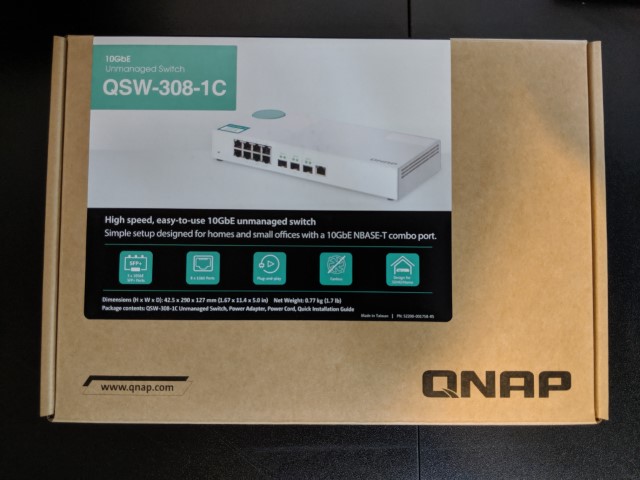
The contents of the retail kit are not much (it rarely is with switches, given that they are made to sit within existing equipment) but it arrives well packaged and each part neatly contained. Once I removed the contents from its retail packaging, I found that it did not include any LAN cables. This is not a big deal, given these are ridiculously cheap (plus even if they did, they would not logically include SFP+ cables, DAC or otherwise) it’s a shame they didn’t include them. Again, this is a very minor gripe and in the interests of affordability and preventing waste, it makes sense (most network-enabled client devices will have a cable included). Inside we found
- QNAP QSW-308-1C Switch
- External Power Supplier
- Quick Start & Installation Guide
- External Power Connector
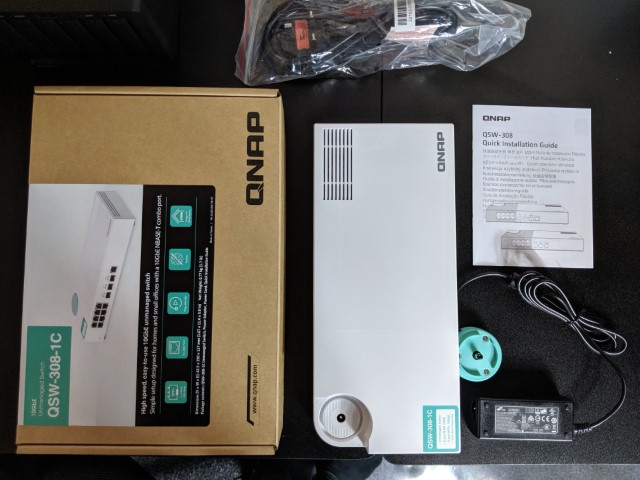
This is pretty much everything you are going to need to get this device up and running in your environment, but I did want to take a moment
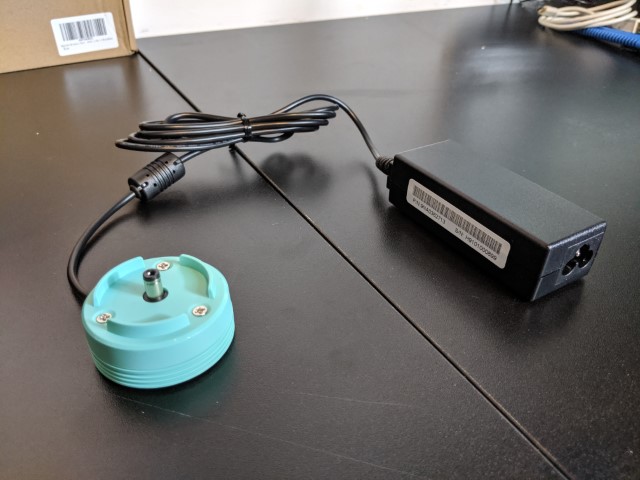
The external PSU connector on the QSW-308-1C is really unique and actually quite quirky. Featuring a rotational base for easy cable layouts, this device also features fanless design where cooling is handled by passive heatsinks inside. The result is that the QSW-308-1C is near silent when in use and has even incorporated a modernised take on the power connector. This has led to a slightly unique colour and chassis design that I will talk about later, but I quite like it and when I deploy this switch for later testing, the rotational power connector was quite useful in a tight corner of the studio.
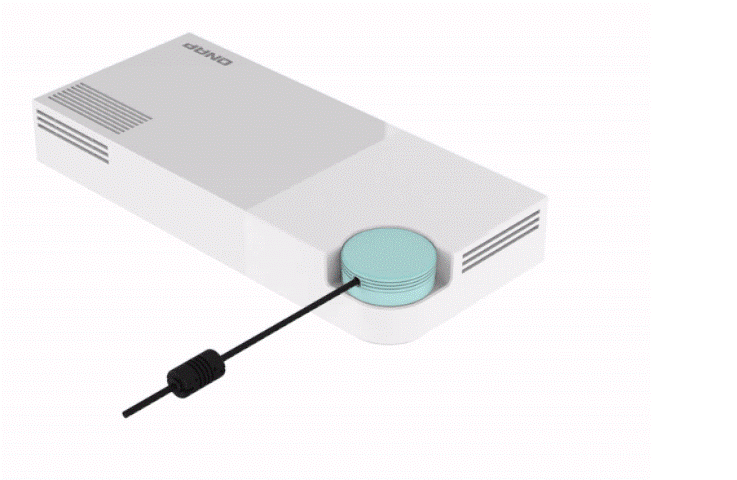
I can appreciate that this kind of connector and design is not for everyone, so if this is not really for you, then you may want to switch to the more classical and techie favoured QSW-1208-8C 12 Port 10Gbe Switch. Anyway, on with the review.
QNAP QSW-308-1C 10Gbe Switch Chassis Design
Once I unpacked everything, I was able to get a good look at this switch in all its glory. I still can’t get over how a switch that features technically 12 ports is still able to be so compact in design. Measuring at just 42.5 x 290 x 127 mm, this device can be deployed very easily indeed. There are of course factors such as ventilation that we will talk about in a bit, that are a key factor in fanless devices, but nevertheless, this is a very compact device that has been chiefly designed to be utilised in environments where space is limited or discretion is key.
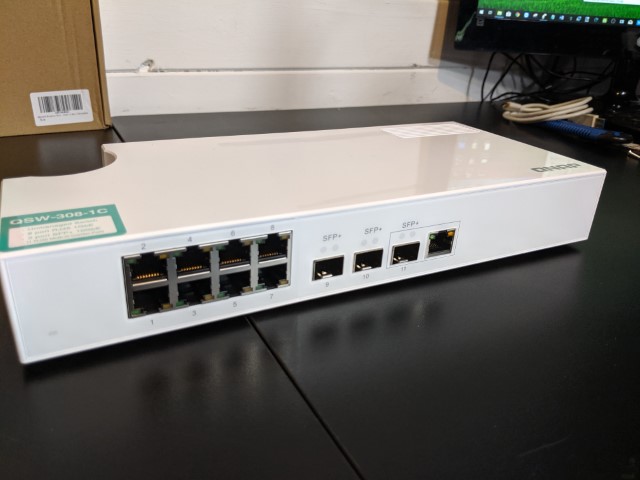
Taking a closer look at the top of the device we can see the white plastic chassis and rotational PSU point mentioned earlier. The casing is fairly nondescript and it is as you would expect from a device that is designed to just be set up and forgotten. However, a closer look let us get a better idea of how this device maintains efficiency.
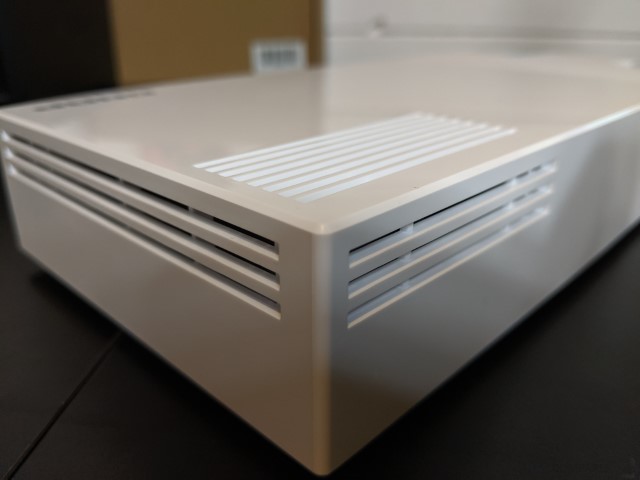
Multiple ventilation points are featured on the QSW-308-1C switch too promote passive airflow and cooling whilst the device is in operation. Most first-time network users are unaware of just how much heat is generated by a network switch compared to that of the router provided by an internet service provider (ISP).
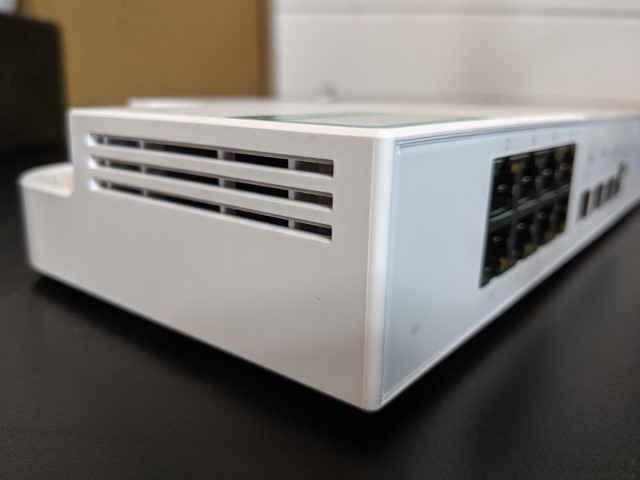
These vents serve as a way for the processors and heatsinks inside to maintain a workable environment and without them, they would be susceptible to performance degradation and damage caused by overheating. You should always store your network switches, whether they are fanless or not, in a well-ventilated area as they are never truly idle devices and will be operational 24/7 in one capacity or another. Though obviously, the more devices that are on the network, the more the switch will work. The switch contains multiple processors and controllers that work together to maintain high speeds, despite the QSW-308-1C device’s unmanaged nature. These multiple areas of ventilation found on all sides of the QSW-308-1C ensure that passive airflow can maintain internal temperatures at a workable level, despite the silent fanless design that it has been chosen.
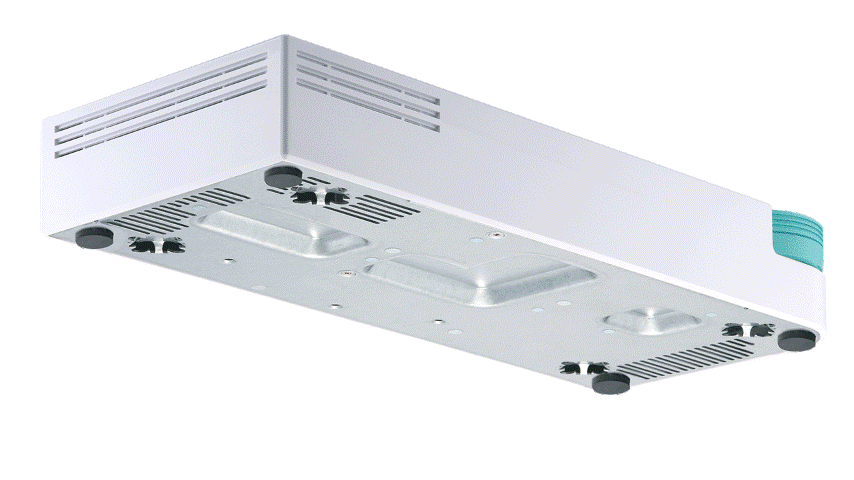
Equally, the QNAP QSW-308-1C features rubberized feet that serve as both a means to stabilise the switch, but more importantly raise the QSW-308 switch from the surface to ensure heat can be dissipated from beneath the device whilst in operation. At this stage, I am pleased with the sheer weight of passive cooling featured on this chassis while still keeping it aesthetically pleasing. Though this will appeal to users looking for a quiet, low-power 10Gbe enabled switch, I think user’s user’s who intend on maximizing all connections at the same time may want to consider an active cooling (fan) based solution instead.
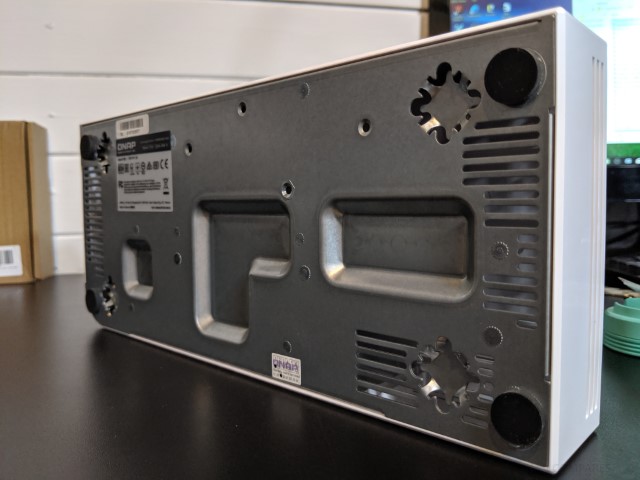
The front of the QSW-308-1C combo switch features a plethora of ports and indicators as you would expect from a pivotal and central network device. It may look a bit of a confusing combination to those new to network devices, but actually a remarkably impressive array of connectivity.
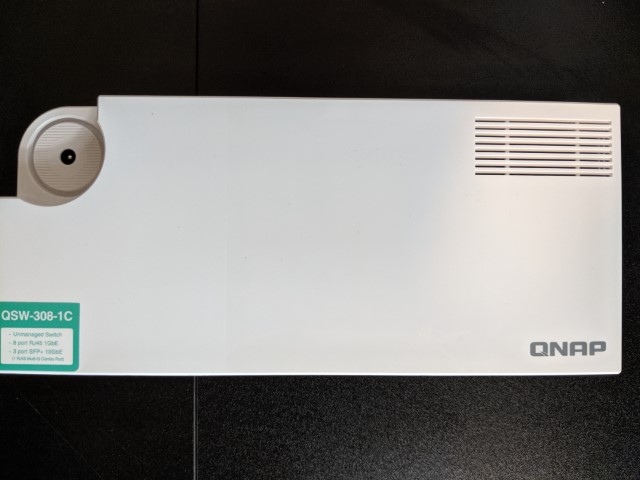
Every single network port features twin LEDs that denote active connections and network traffic. Ask any veteran techie and they will tell you about the importance of these lights, as they serve as the most basic but reliable form of acknowledgement that two devices are talking. A number of truly budget solutions in the past from companies such as D-Link and TP-Link have tried to cut corners by minimising these indicators, creating brainless and lightless boxes, that have the potential to infuriate you down the line. Do yourself a favour and spend the few extra quid it costs to have them, as they only have to be there for you on one occasion to save you hours of trial and error.
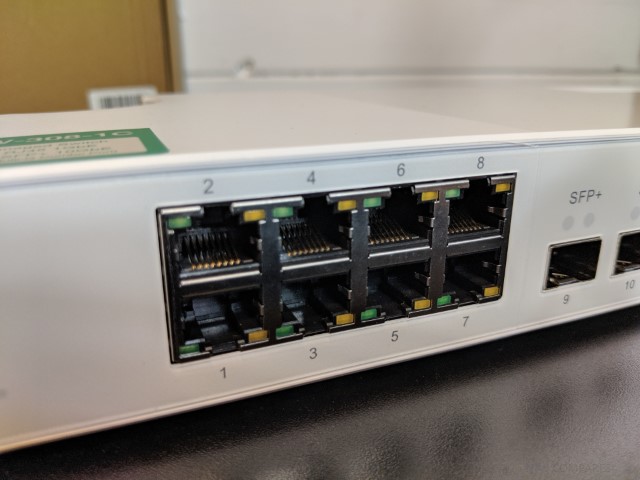
The most mainstream and common connection available on the QSW-308-1C QNAP switch is the copper-based RJ45 1GBe connectivity found on the left-hand side. These 8-ports serve as the means for all of your connected devices to exchange packets of data on your network environment, though it is worth remembering that this switch is affordable for many reasons and one of them is that it is an unmanaged switch. That means that you cannot access a configurable back-end via an app or browser-based user interface for features such as port-trunking (aka link aggregation) and adaptable port priorities. Before you go any further, let’s take a moment to understand the difference between a managed and unmanaged switch:
What is an Unmanaged Switch?
As mentioned above, an Unmanaged Switch simply allows Ethernet devices to communicate with one another, such as a PC or network printer, and those are typically what we call plug and play. They are shipped with a fixed configuration and do not allow any changes to this configuration. An Unmanaged Switch is typically used in small networks or to add temporary workgroups to larger networks.
What is a Managed Switch?
Managed Switches provide all the features of an Unmanaged Switch, but also provide the ability to configure, manage, and monitor your LAN. Furthermore, a Managed Switch gives you more control over your LAN traffic and offers advanced features to control that traffic. The key difference between Managed and Unmanaged Switches is the ability to configure the Switch, as well as the connectivity of any/all users as and when needed.
For those looking for a simple network environment where devices can access one another and communicate over an equal playing field up to 1 gigabit (100MB per second) maximum transmission, these 8-ports will serve as more than enough connectivity. However, if that is all you are looking for then this QSW-308-1C switch from QNAP maybe quite a lot of overkill. This device is about servicing your network connections today, tomorrow and in years to come.
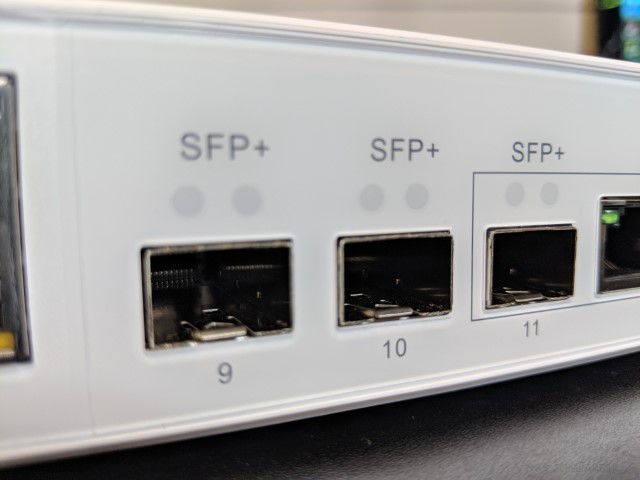
Next to these RJ45 ports, we find the serious connectivity, in the form of the fibre-based 10 gigabit Ethernet SFP+. These three fibre standard ports allow users with the appropriate connections to get 10 times the network speed of the RJ45 port previously mentioned. Fibre is the more expensive network alternative to copper found in most home and mid-level business environments, because it is able to maintain much higher speeds over vastly greater distances. Indeed, these port even require dedicated controllers attached to each end of the cabling known as SFP+ transceivers and if you intend to utilise the SFP+ ports on this affordable switch, you will need to ensure that you are using individual transceivers or DAC transceiver equipped cables of up to 3 or 5m, or purchase dedicated 10-gigabit enabled transceivers and fibre cabling separately. Nevertheless, these three ports will give you fantastical speeds to three separate SFP+ devices in your network environment, but it is worth remembering once again that this is an unmanaged switch and therefore link aggregation of these port is not possible.
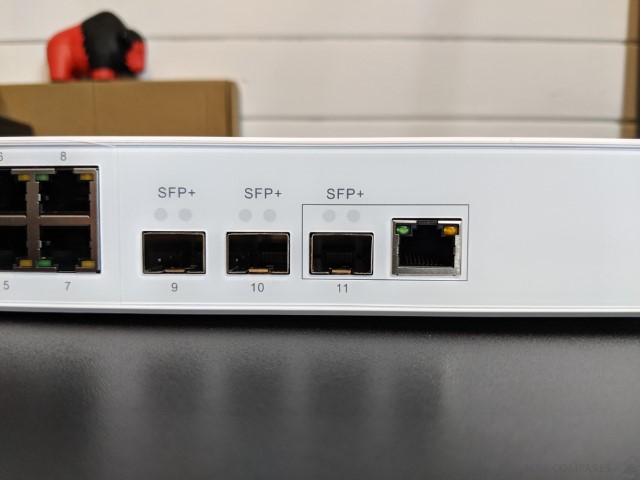
Which leads me neatly to a particularly cool feature on the QNAP QSW-308-1C switch in the form of the copper-based 10Gbe port and combo support. If you have a network environment that features a mixed combination of ports network speeds and physical connectivity, then the QSW-308-1C switch may be the affordable way for you to provide cross connectivity for all of these platforms. The QSW-308-1C features combo support allowing you to attach both a 10Gbe SFP+ connection and a 10Gbe RJ45 (10GBASE-T) connection and let these two ports share the same network environment. This will be particularly advantageous to users making the jump from 1Gbe to 10Gbe, but have a mixed hardware environment spread across their devices. Utilising the 10GBASE-T connection means that you can only utilise a single SFP+ port in conjunction, but this serves as a great stepping stone for those looking to upgrade their network environment in a more granular or gradual accessory fashion. as well as utilising many of the QNAP adaptors mentioned at the start of this review.
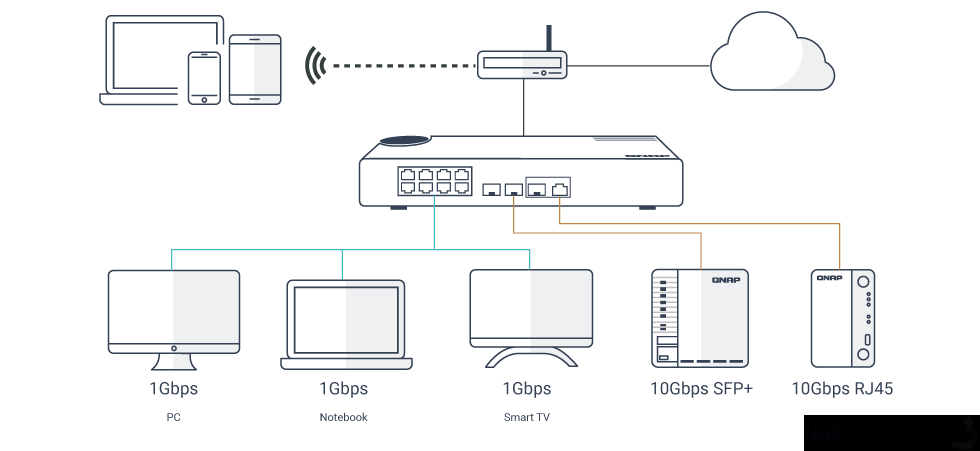
QNAP QSW-308-1C 10Gbe Switch Conclusion
The QNAP QSW-308-1C switch definitely lives up to what it promises and has a very clear target user in mind. It does not pretend to be more than it is and because of that can maintain a high performance and low price-tag for users looking to move to the next level of networking without spending thousands. The QSW-308-1C serves as a great upgrade for users moving from gigabit ethernet and towards multi-gigabit environments and with fantastic growth in 2019 towards 2.5G, 5G and 10Gbe in affordable hardware, the need for a more palatable and affordable upgrade to this tier is not only hugely welcome but fast becoming an inevitability.
That said, the QSW-308-1C is not for everyone, as if you already have a multi-gigabit network environment in place or have need of a more controllable and priority defining network environment in mind, you will probably find the QSW-308-1C a backstep and limiting in its scope. But the QSW-308-1C is not designed for that and does not pretend to be so, and with QNAP having released and in the process of releasing switch options to cater to an ever-evolving network clientele, whether this is the switch for you or not, by the end of 2019 QNAP will almost certainly have a switch that suits your needs and budget. Bottom line, I really like this device and couldn’t see myself finding many uses for this device for aspiring YouTubers like me as well as day-to-day data work in general.
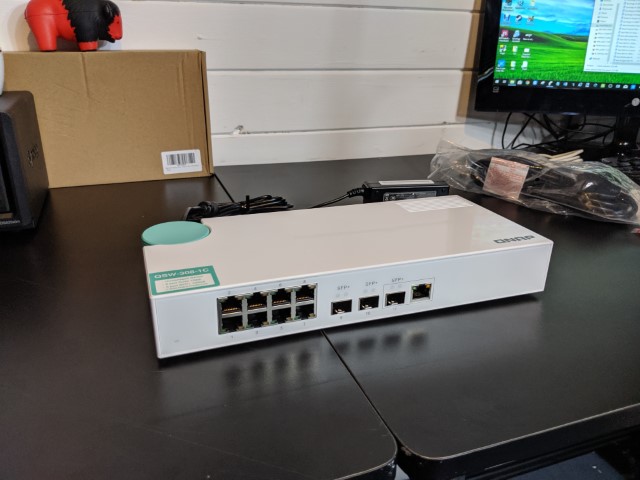
If you plan on buying your QNAP QSW-308-1C 10Gbe Switch from Amazon, please support this site by using the link before, as we receive affiliate marketing that goes directly into support this site and out free advice! Thank you for reading.
| Pros of the QNAP QSW-308-1C Switch | Cons of the QNAP QSW-308-1C Switch |
|
|
🔒 Join Inner Circle
Get an alert every time something gets added to this specific article!
This description contains links to Amazon. These links will take you to some of the products mentioned in today's content. As an Amazon Associate, I earn from qualifying purchases. Visit the NASCompares Deal Finder to find the best place to buy this device in your region, based on Service, Support and Reputation - Just Search for your NAS Drive in the Box Below
Need Advice on Data Storage from an Expert?
Finally, for free advice about your setup, just leave a message in the comments below here at NASCompares.com and we will get back to you. Need Help?
Where possible (and where appropriate) please provide as much information about your requirements, as then I can arrange the best answer and solution to your needs. Do not worry about your e-mail address being required, it will NOT be used in a mailing list and will NOT be used in any way other than to respond to your enquiry.
Need Help?
Where possible (and where appropriate) please provide as much information about your requirements, as then I can arrange the best answer and solution to your needs. Do not worry about your e-mail address being required, it will NOT be used in a mailing list and will NOT be used in any way other than to respond to your enquiry.

|
 |
Beelink ME Pro NAS Revealed
Best SOLID STORAGE NAS of 2025
Should You Worry About the NanoKVM Hidden Microphone?
Best Cheap NAS of 2025
Minisforum MS-02 Ultra - WHO IS THIS FOR??? (The First 48HRs)
Why People Use TrueNAS, UnRAID and Proxmox to Turnkey NAS (Synology, QNAP, etc)
Access content via Patreon or KO-FI





Discover more from NAS Compares
Subscribe to get the latest posts sent to your email.


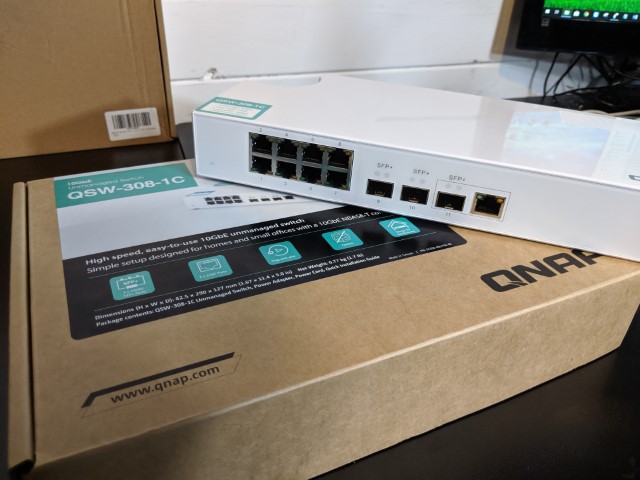




DISCUSS with others your opinion about this subject.
ASK questions to NAS community
SHARE more details what you have found on this subject
IMPROVE this niche ecosystem, let us know what to change/fix on this site